
Pro-abortion critics slam Gwen Stefani for partnering with Catholic Hallow app
Nancy Flanders
·
Analysis: Younger adults plan to have even fewer children than a decade ago
As global birth rates continue to struggle to meet replacement rate, a new Pew Research Center analysis reveals that U.S. adults in their 20s and 30s plan to have even fewer children than adults a decade ago.
Adults in their 20s and 30s had a much higher intended birth rate a decade ago than they do today.
Among several age groups, a steeper decline is seen among those attaining four-year degrees.
Just three-quarters of men and women plan to have at least one child — down from 90% in 2012.
The only group of women still achieving replacement rate in 2023 was among those ages 35-39.
Pew asked people what they felt would encourage families to have more children; the top responses mentioned financial benefits in some way (tax credits, free child care, paid family leave, etc.).
The analysis, published by Pew on June 18, states, “The total number of children that women and men ages 20 to 39 planned to have, on average, dropped from 2.3 in 2012 to 1.8 in 2023. Those numbers remained stable from 2002 to 2012.”
Replacement rate (the number of children needed on average per woman to replace the population) is considered to be 2.1. Anything below this number indicates a dangerous downward trend — and Pew says these declines have happened almost entirely in just the past decade. The analysis noted that from 2012 to 2023, the “total number of children that women planned to have” dropped significantly:
2.3 to 1.5 for women ages 20 to 24
2.3 to 1.9 for women ages 25 to 29
2.5 to 1.9 for women ages 30 to 34
Similar declines were seen among men in these age groups. Pew added, “There was not a significant drop for women ages 35 to 39.”
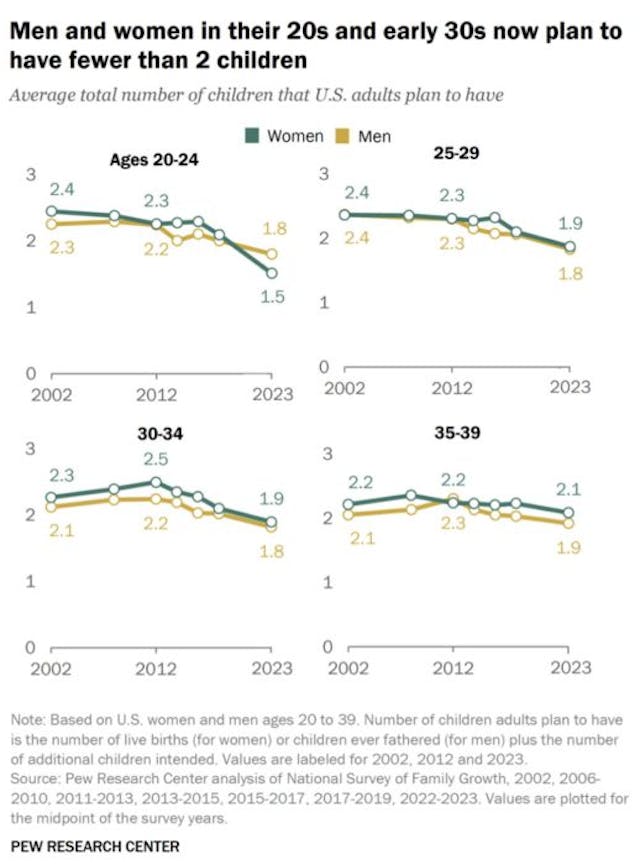
Interestingly enough, the analysis also found that women who attained a four-year college degree had a much lower intended birth rate than those who did not. It stated, “In 2023, the total number of children that women ages 25 to 39 planned to have was [] 1.7 among those with a college degree [and] 2.2 among those without a college degree.” This age group was selected for analysis because this age group has “mostly completed their education,” according to Pew.
But among men with varying education degrees, the intended birth rates were practically the same.
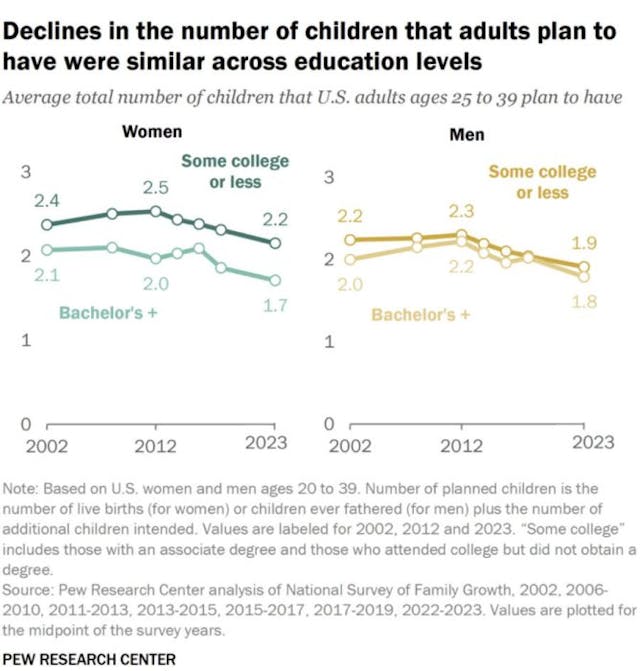
The analysis also noted that, “In 2023, about three-quarters of men (76%) and women (77%) had or planned to have at least one child. This was down from about nine-in-ten [90%] in 2012.”
The biggest drop was seen among women between 20 and 24. In 2002, 93% of women in this age group planned to have at least one child; by 2023, that had dropped by nearly a third, to 66%.
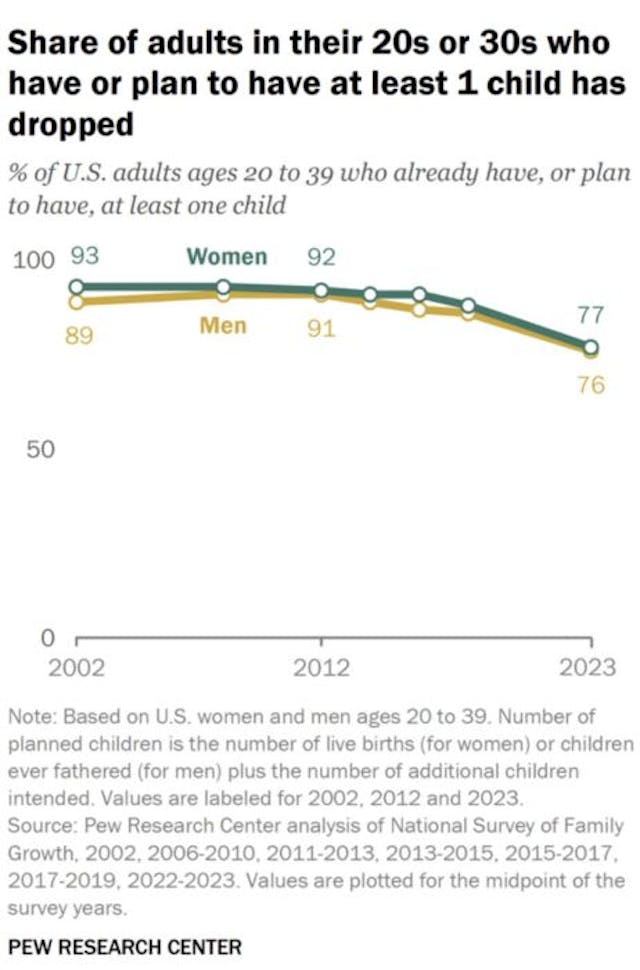
Pew states that in 2024, they asked people about whether they felt the impact on the U.S. would be positive or negative if fewer people chose to have children. The results showed the following:
Article continues below
Dear Reader,
Have you ever wanted to share the miracle of human development with little ones? Live Action is proud to present the "Baby Olivia" board book, which presents the content of Live Action's "Baby Olivia" fetal development video in a fun, new format. It's perfect for helping little minds understand the complex and beautiful process of human development in the womb.
Receive our brand new Baby Olivia board book when you give a one-time gift of $30 or more (or begin a new monthly gift of $15 or more).
47% – negative impact
20% – positive impact
31% – neither positive nor negative impact
Are women who attain college degrees more focused overall on desiring and achieving career success than on building families? Pew’s analysis shows that, perhaps until their mid-thirties, this may be the case. However, there may be more at play than a simple desire for career success.
When Pew asked people what they felt may encourage more people to have children, the top ideas they listed seemed to focus on finances in some way. Here’s what they felt would likely encourage family growth:
60% – free child care
51% – paid family leave
49% – more tax credits
45% – monthly payment for parents of minors
Again, notice the financial theme – cost savings, time with family without losing income, relief on their tax burden while raising children, and even receiving money just to help with expenses when raising children.
If we were to examine only these items above, we might conclude that women (and men) in their 20s and 30s are most concerned with establishing themselves financially before they even consider having children.
Perhaps women aged 35-39 feel more financially secure — or at least secure enough to have seen almost zero change in birth rate over the past decade when that of women from all other age groups dropped.
In today’s world of rising costs, women and men may be finding the idea of having children even more difficult — or unrealistic. Sometimes this leads people to choose abortion for financial reasons.
Ultimately, if we can help to ease the financial burdens of people in their childbearing years, it is likely to benefit all of society, not just a few. Declining birth rates lead to a demographic winter, which eventually results in societal economic collapse.
When people opine that “the children are our future,” they may not even realize just how right they are.
Live Action News is pro-life news and commentary from a pro-life perspective.
Contact editor@liveaction.org for questions, corrections, or if you are seeking permission to reprint any Live Action News content.
Guest Articles: To submit a guest article to Live Action News, email editor@liveaction.org with an attached Word document of 800-1000 words. Please also attach any photos relevant to your submission if applicable. If your submission is accepted for publication, you will be notified within three weeks. Guest articles are not compensated (see our Open License Agreement). Thank you for your interest in Live Action News!

Nancy Flanders
·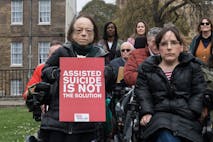
International
Cassy Cooke
·
Issues
Sheena Rodriguez
·
Human Interest
Nancy Flanders
·
Issues
Bridget Sielicki
·
International
Angeline Tan
·
Human Interest
Kelli Keane
·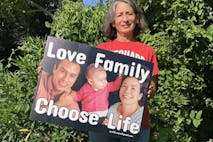
Activism
Kelli Keane
·
Politics
Kelli Keane
·
Human Interest
Kelli Keane
·
Abortion Pill
Kelli Keane
·